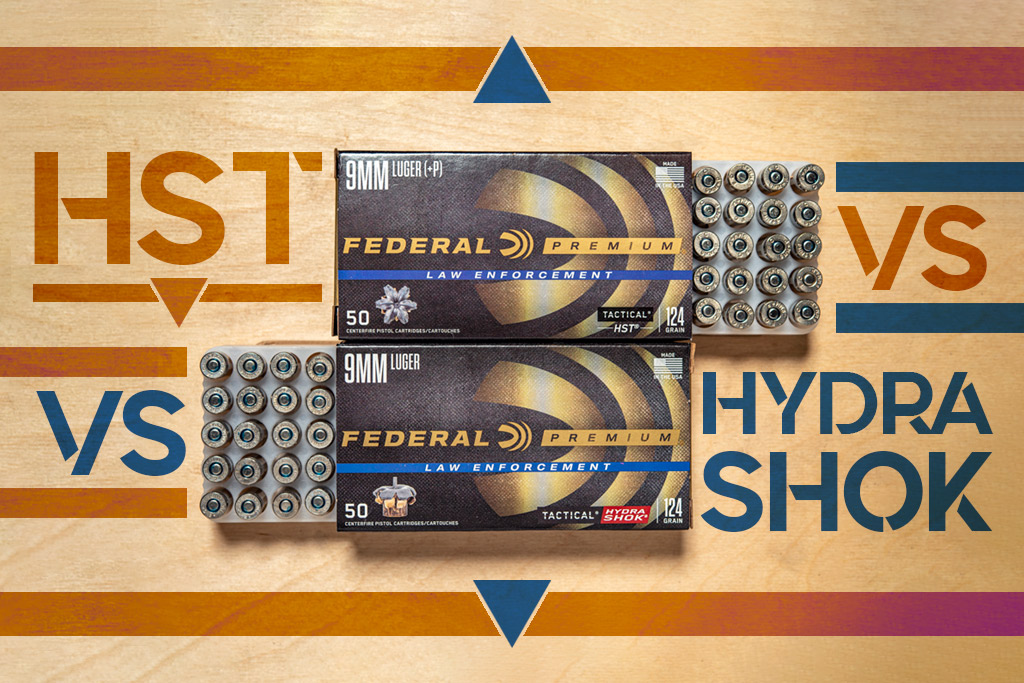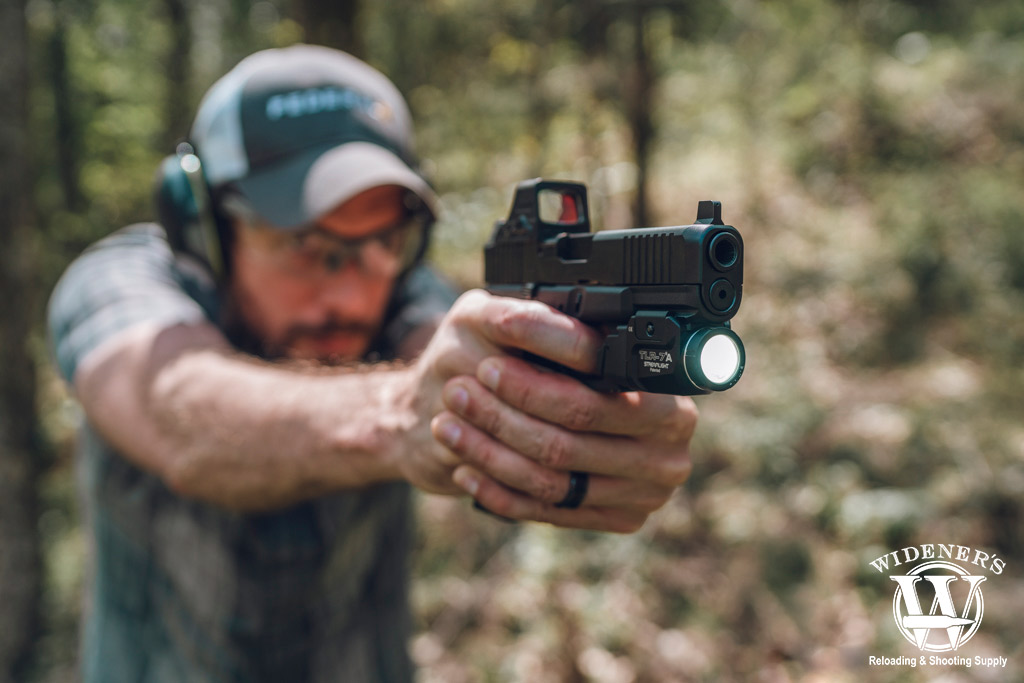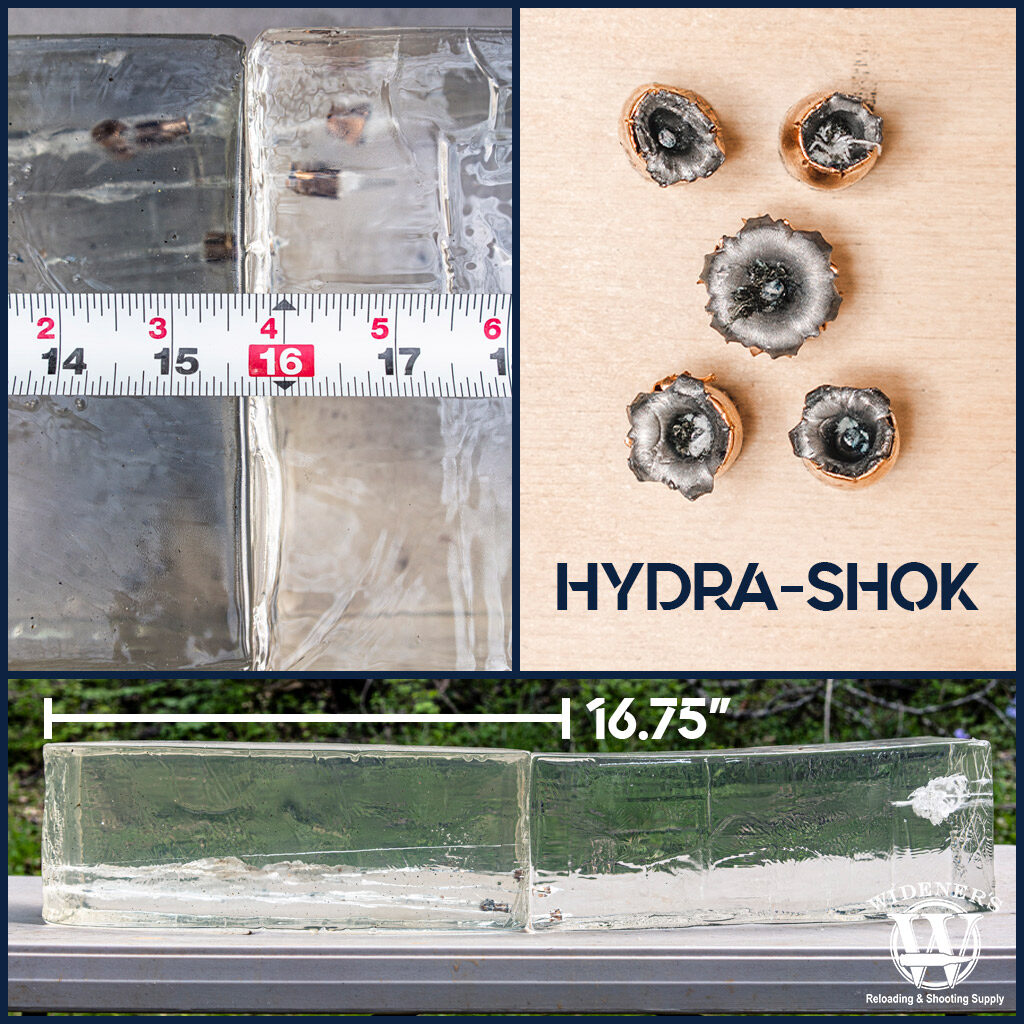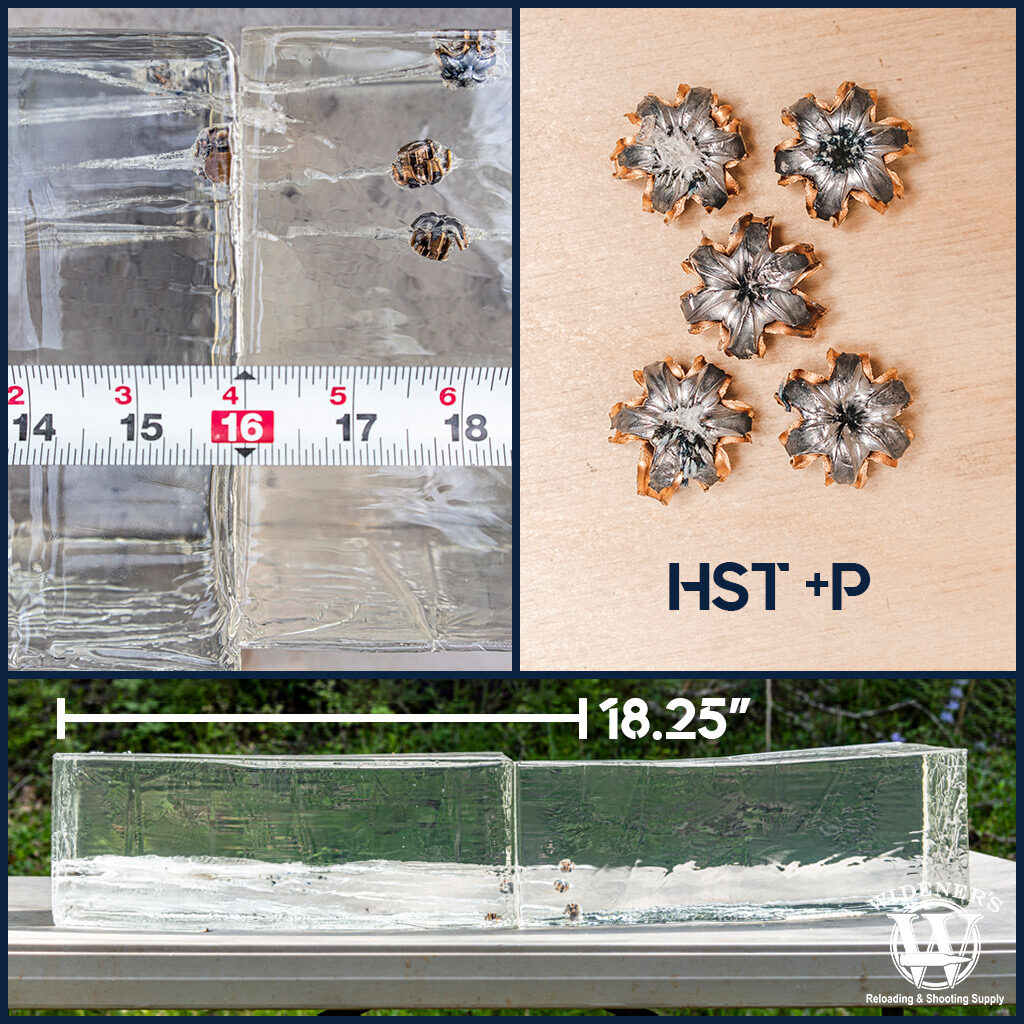

By Guy J. Sagi
The physics, math, and metallurgy poured into modern bullet design is staggering. Advances are often cutting edge, particularly when it comes to self-defense projectiles. Federal Ammunition, one of the foremost in the field, understands no two situations or needs are identical. For that reason, it offers versions that bring different assets to the fight, a fact highlighted when comparing two of its best—Federal HST VS Hydra-Shok.
Both bullet designs have been around the block and have a track record of performance. Federal introduced the HST as a barrier penetrating upgrade in 2002. At first, it was only available to law enforcement, but commercial sales began in 2015.
Hydra-Shok hit retail shelves the year Warrant released “Heaven”—1989, to be precise. That chart-topping tune may’ve faded from our collective memories, but the Hydra-Shok remains a top choice among gun owners to this day.
Federal HST VS Hydra-Shok: Mission Critical

Federal HST VS Hydra-Shok: Hydra-Shok (Left) has a post in the center, while HST (Right) is a standard JHP design.
Both cartridges perform the self-defense bullet mission with enviable dexterity. They expand (upset, in more precise ballistics terms) on impact, create a wound channel significantly wider than their original caliber and retain mass to ensure penetration.
There’s another critical advantage to their hollow point performance. When bullets assume a significantly larger diameter after striking tissue, their speed slows and travel hopefully ends at the target. That virtue minimizes the chances of it exiting and injuring innocent bystanders.
That’s far from what all manufacturers consider when developing self-defense loads, though. The shorter barrels so popular for concealed carry today reduce bullet velocity, which forces designers into a delicate balancing act. Even tiny increases in powder charge create more recoil, slow follow-up shots and, worse yet, risk bullet launches above their optimal performance speed.
Add the need to minimize muzzle flash to avoid temporarily blinding the shooter and it’s obvious why companies eagerly harness new technology to fine-tune cartridges. When it comes to self-defense any advantage, even a minor one, is a welcome ally.
Performance VS Reliability
All the factors come into play when designing the right lifesaving load, but each takes a back seat to unfailing reliability. In our Federal HST VS Hydra-Shok cycle testing, there were no failures to feed or any stoppages. A duty-size Springfield XD in 9mm ran both loads without fail, and the reliability was identical in a .45 ACP Wilson Combat 1911 CQB. Magazines, handguns, and temperaments vary though, so range sessions are in order before you rely on anything to protect yourself and your loved ones. Confidence in your gear is an underrated asset.
Ballistic Renaissance
Both bullets shine in the FBI testing protocol that has become the industry’s gold standard for terminal performance. The rounds passing that test is a resounding endorsement that they can stop a criminal attack with authority, assuming proper shot placement and conditions.
The Bureau’s testing is rigorous and includes hurdles specific to law enforcement needs, but evaluation of bullet performance wasn’t always so standardized. Thirty years ago, the Navy, Immigration and Naturalization, the Secret Service, and the National Institute of Justice conducted their own versions using slightly different protocols aimed at their specific missions. The results were often different and confusing.
Then in 1986 a tragic FBI Miami shootout took place, claiming the lives of two FBI special agents. The pair of armed robbers wounded another five agents before the gun battle ended. Studies of the deadly encounter later determined the ammunition officers were issued failed to perform. Both criminals died at the scene, although it took six shots to take one out of the fight and a dozen to stop the second perpetrator.
The Semi-Auto Revolution
The FBI soon began migrating from revolvers to 10mm semi-auto pistols, but also took a closer look at bullet performance. Hollowpoint expansion and energy transfer shined in bare ballistic gelatin tests, but the fact that bullets must pass through clothes before reaching a criminal lacked emphasis. Even when going through a light shirt many of those early bullet designs collected enough debris in their nose cavity to act as a traditional FMJ.
Today the FBI protocol also includes sending bullets through two pieces of 20-gauge galvanized steel, automobile glass, plywood, wallboard, and heavy clothing. For the average law-abiding citizen, the latter is the most critical consideration and the one some claim the Hydra-Shok stumbles slightly on.
Ballistic Testing: Federal HST VS Hydra-Shok
Hydra-Shok
In our Hydra-Shok ballistic test, we fired five rounds using a Glock 45 pistol with a 4″ barrel. The ammunition used was Federal Premium LE Hydra-Shok 124gr JHP. We used the FBI standard distance of 10ft, shooting into two gel blocks with a four-layer fabric barrier. One round fully expanded, four showed partial expansion, and all captured some of the fabric material in the well. The Hydra-Shok had an average velocity of 1065 FPS. The ammo experienced an average penetration depth of 15.6″ with 16.75″ being the deepest point. The ammo had a 2.25″ difference in grouping distance when at rest inside of the gel block.
| Ammunition Velocity | Shot #1 | Shot #2 | Test Shot #3 | Shot #4 | Shot #5 | Average Velocity |
|---|---|---|---|---|---|---|
| Federal Premium LE Hydra-Shok 124gr JHP | 1073 | 1080 | 1064 | 1050 | 1060 | 1065 FPS |
Cartridge Overview
Thomas J. Burczynski counts the Hydra-Shok among his many patents. His design was genius. It came at a time when most believed generic hollowpoints were the ultimate solution and even preceded the FBI’s launch of today’s standardized barrier testing. It has a post rising from the middle of the hollowpoint that, with close inspection, gives it a rather menacing look. It’s not a fashion accessory, though.
It tapers toward the base and is cleverly short enough to avoid protruding above the bullet nose, a profile that could increase overpenetration. In fact, it does the opposite. When the bullet strikes a soft target the post drives back into the non-bonded lead core and increases the speed at which the hollowpoint upsets.
In addition, the bullet wears a notched copper jacket to control and maintain weight as the bullet expands on impact. Nickel-plated casings ensure reliable feeding and, if that unthinkable criminal encounter takes place in the dark, maximize their visibility of spent ones on the floor if you need to move.
Today Federal offers Hydra-Shok loads in .32 ACP, .38 Spl., 9x19mm, .357 Mag., .40 S&W, 10mm, .44 Mag. and .45 ACP in a variety of bullet weights. The company even makes low-recoil variants, in a line that expands to include .327 Fed. Mag. and .380 ACP loads.
It’s not uncommon to hear claims that Hydra-Shok sometimes exhibits unreliable expansion after passing through clothing or other barriers. As a result, Federal unveiled a Hydra-Shok Deep variant in 2017 with a slightly different look and allegedly improved penetration. The jury’s still out on whether the new cartridge is an improvement. Although, law enforcement agencies and law-abiding citizens still using the cartridge remain apparently unconvinced.
The introduction, however, underscores Federal’s willingness to continue improving its self-defense line, which also includes another approach.
Federal HST +P
In our HST ballistic test, we fired five rounds using a Glock 45 pistol with a 4″ barrel. The ammunition used was Federal Premium LE HST 124gr +P JHP. We used the FBI standard distance of 10ft, shooting into two gel blocks with a four-layer fabric barrier. All five rounds expanded and captured some of the fabric material in the well. The HST +P had an average velocity of 1153 FPS. The ammo experienced an average penetration depth of 16.7″ with 18.25″ being the deepest point. The ammo had a 3.25″ difference in grouping distance when at rest inside of the gel block.
| Ammunition Velocity | Shot #1 | Shot #2 | Test Shot #3 | Shot #4 | Shot #5 | Average Velocity |
|---|---|---|---|---|---|---|
| Federal Premium LE HST 124gr +P JHP | 1150 | 1164 | 1120 | 1180 | 1155 | 1153 FPS |
Cartridge Overview
When Federal introduced its HST design it was vastly different from the Hydra-Shok. Tom Burczynski again worked on the development, but he didn’t reach back to his cutting-edge—at least at the time—playbook of using a post in the hollowpoint’s center. This new bullet design even shrugs off the tried-and-true method of bonding the copper jacket to the core to maintain bullet weight as it breaches barriers.
Instead, a cannelure in the projectile’s shank maintains core and jacket integrity upon impact. A grooved surface on the jacket promotes controlled expansion and ensures the bullet assumes a star-like shape at upset, rather than a circumference-filled area that can impede penetration.
It’s an interesting approach that works. Despite passing through clothing and other barriers, its penetration is nearly identical to what it exhibits through bare ballistic gel. It’s making many rethink hollowpoint performance and what was once considered its design limitations.
Federal currently has HST loads available in .38 Spl., .357 Sig., 9x19mm, 10mm, .40 S&W, .45 ACP, and the new-for-2022 .30 Super Carry. For those who rely on small-barreled handguns, the company also offers several Micro variants tailored for their needs. Naturally, casings throughout the line are nickel-plated.
Showdown: Federal HST VS Hydra-Shok

Barrier penetration and velocity give HST the edge for self-defense. However, despite its age, Hydra-Shok isn’t far behind.
There’s no other way of putting it, both Federal lines are a winner. The Hydra-Shok has a long and undeniable history of attack-stopping performance. The HST has also been around (and through) the block. Despite its deceptively simple approach, it performs its mission with superb consistency. Regardless of your Federal HST VS Hydra-Shok choice, you can’t go wrong.
There are, however, some considerations. Perceived recoil from HST +P loads is stouter. In the handguns used for testing it wasn’t a concern, although the velocity numbers don’t lie. Even from a 4″ barrel, it’s pushing close to 1,200 FPS.
The 9mm, 124-grain HST +P load, for example, generates 366 ft.-lbs. of energy at the muzzle. The Hydra-Shok cartridge with the same weight bullet comes in at 312 ft.-lbs. It’s not much, but on a light handgun worth noting for recoil-sensitive enthusiasts.
HSTs are also slightly more expensive per round. It’s not a significant increase, particularly when you consider the loads are tailored for self-defense, not high-volume plinking. You can also decrease the cost per round by buying in bulk.
The Final Word
The biggest considerations, however, are performance and availability.
Hydra-Shoks are available in more chamberings, with low-recoil offerings and even a new “Deep” variant. Although they penetrated less deeply, that may be a deciding factor for those looking for a home defense round. Our testing also showed that Hydra-Shok expansion wasn’t the most consistent. Meaning, that you may need to fire multiple rounds in a self-defense situation to stop a threat.
HSTs address the shorter barrel pistols, but the lineup isn’t quite as diverse in caliber or bullet weight selection. You can however easily find standard and +P HST rounds. Depending on the self-defense situation, HST rounds may perform more effectively through a variety of barriers. Our ballistic test showed that they have deep penetration, as well as consistent expansion.




